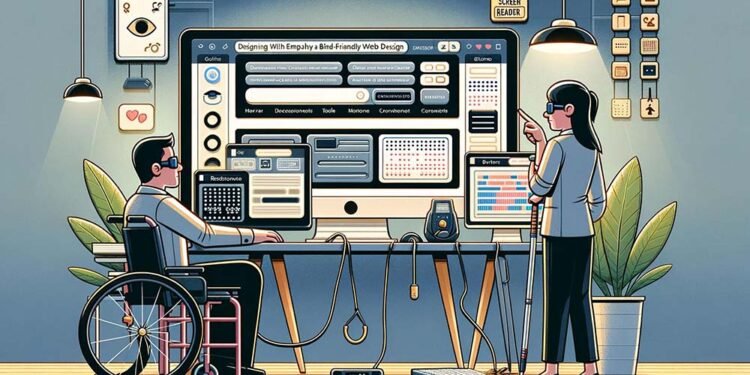In the digital era, websites serve as the primary medium for information, services, and engagement. However, the vast potential of the web remains partially untapped due to accessibility barriers that prevent millions of users, especially those who are blind or visually impaired, from fully participating. Accessibility in web design is not merely a technical requirement but a fundamental component of inclusive digital spaces. It ensures that all users, regardless of their physical abilities, can navigate, understand, and interact with web content effectively. By prioritizing accessibility, web designers and developers can bridge the gap, fostering an environment where information and services are truly universal.
Empathy stands at the core of creating websites that are genuinely accessible to blind and visually impaired users. It involves more than just adhering to guidelines; it requires an understanding of the challenges these users face and a commitment to solving them through design. Empathy in web design means putting oneself in the shoes of blind users to appreciate the barriers they encounter. This empathetic approach encourages designers to go beyond compliance, inspiring innovative solutions that enhance usability and ensure that blind users can engage with websites in meaningful ways. By viewing design through the lens of empathy, creators can develop more nuanced, accessible, and user-friendly digital experiences.
In today’s interconnected world, the concept of a blind website — a site optimized for blind and visually impaired users — is gaining traction as a critical aspect of web development. The push towards digital inclusivity highlights the need for websites that are accessible to all, including those relying on screen readers and other assistive technologies to browse the internet. The design of a “blind website” is not just about technical accessibility; it’s about creating equitable and engaging online experiences for every user. As digital platforms become increasingly central to everyday life, the importance of designing websites with blind users in mind has never been more pronounced. This shift towards empathetic and inclusive web design marks a significant step forward in building a more accessible digital world for everyone.
Understanding Blind Users’ Web Navigation Needs
Navigating the web presents unique challenges for blind users, who rely on auditory and tactile cues through screen readers and Braille displays. These tools translate web content, making structured, semantic HTML vital for clear navigation and comprehension. Designers must ensure their websites accommodate these technologies by providing logical layouts, descriptive links, and alt text for images, fostering a web environment where blind users can navigate with ease and independence.
Screen readers and Braille displays are essential for blind users to access and engage with digital content. To support these technologies, websites must avoid complex designs that confuse assistive tools and ensure all elements are clearly labeled. This approach not only enhances accessibility but also empowers blind users to participate fully in the digital world, from reading articles to online shopping.
The frustration blind users face on poorly designed websites underscores the need for empathy in web design Penrith. Challenges such as unclear site structures, missing alt text, and inaccessible forms hinder the online experience. By addressing these issues proactively, developers can create more inclusive and navigable blind websites, improving the digital landscape for blind users and emphasizing the importance of thoughtful, empathetic design.
Empathy in Action: Key Principles of Blind-Friendly Web Design
Empathy is crucial in designing websites that genuinely serve blind and visually impaired users. It goes beyond adhering to accessibility guidelines, emphasizing understanding users’ experiences to create inclusive digital environments. This approach ensures that accessibility features are not just added on but are integral to the website’s structure, making the web more navigable and meaningful for all users, especially those relying on screen readers or Braille displays.
Empathetic design directly influences the development of more accessible features in blind websites. Designers who empathize with blind users prioritize navigation clarity, descriptive texts, and accessible feedback mechanisms. This focus on intuitive use leads to websites that are more user-friendly for everyone, proving that empathy in design results in practical improvements in accessibility and user experience.
Case studies show that empathetic design significantly improves web accessibility. For example, redesigns that incorporate ARIA landmarks and keyboard navigation make websites more usable for blind users. Similarly, e-commerce sites that offer detailed alt text descriptions enhance the shopping experience for visually impaired customers. These examples underline that empathetic design not only meets technical standards but also creates a more engaging and accessible internet.
Design Elements that Matter to Blind Users
Textual content is vital for blind users to engage with blind websites. Clear, structured text, marked up semantically for screen readers, ensures users can navigate and understand content effectively. Descriptive links and text alternatives for visual elements are essential, enabling blind users to access the same information as sighted visitors, fostering inclusivity and equal access to digital content.
Efficient navigation is key to a positive web experience for blind users. Logical site structure, consistent navigation menus, and accessible sitemaps allow users to form a mental model of the website, facilitating easier information retrieval. Implementing these navigational aids with accessibility in mind ensures blind users can explore websites independently and confidently.
Audio cues and alternative text significantly enhance web accessibility for blind individuals. Audio feedback for interactive elements and descriptive alt text for images provide necessary context, allowing blind users to fully experience web content. Thoughtful incorporation of these features ensures the digital landscape is inclusive, offering blind users a comprehensive understanding of visual and interactive content.
In Conclusion
Empathy is foundational in creating blind websites, guiding designers to go beyond technical accessibility to truly understand and cater to the needs of blind users. This empathetic approach elevates accessibility as an integral part of the design, making the web more inclusive and navigable for everyone.
Accessible design transcends individual user benefits, contributing to a more inclusive society where digital resources are universally accessible. It emphasizes that an inclusive web enhances everyone’s ability to access information and services, supporting the idea that digital access is a universal right.
The push for accessible web design is a collective endeavor that urges web professionals to embrace empathetic practices. This initiative not just improves compliance but fosters a web environment where inclusivity, understanding, and user experience are paramount, encouraging a web that is accessible and enriching for all.












